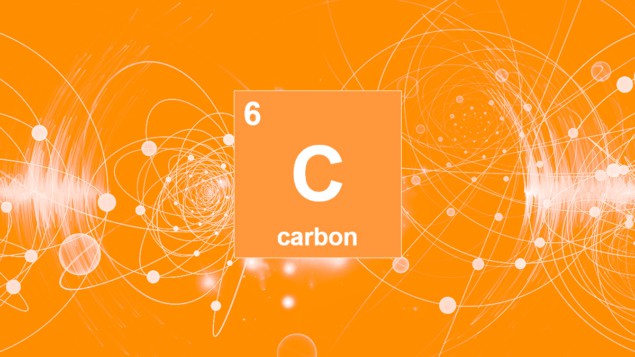Which is your favourite chemical element? To mark the International Year of the Periodic Table, our science journalists will be arguing for their pick from the 118 known elements. In this instalment, Anna Demming argues the case for carbon as a fundamental building block of life and chemistry, and the new science that has emerged from carbon nanomaterials.
 (Adapted from shutterstock/agsandrew)
(Adapted from shutterstock/agsandrew)
What links the Earth and the air? What both sparkles like starlight and reflects almost nothing at all? What underpins the chemistry of biological molecules – life itself – and has launched a whole field of materials science in 2D, not to mention its mechanical, electrical and optical properties, which are worth (to funders at least) billions? In some form or another carbon and carbon compounds take a piece of the action in almost all fields of science.
So what makes carbon so ubiquitous in so many fields? A chemist might think a good place to start is by looking at how carbon bonds to other elements. As a physicist by training, though, I’d add that where it gets really interesting is explained by physics.
Carbon atoms comprise a nucleus of neutrons and six protons surrounded by six electrons. Quantum mechanics dictates that the first two electrons occupy the inner atomic orbital, while the remaining four electrons have wavefunctions that only half-fill the second standard and three second principal orbitals. This leaves each carbon atom hungry to bond with other atoms. Hydrogen aside, there are more compounds of carbon than any other element, and these include the whole of organic chemistry.
Chemical promiscuity
The most basic organic molecule is methane – one carbon atom bonded to four hydrogen atoms. The tetrahedral shape formed by the four hydrogens gives each of carbon’s outer electrons as much distance as possible from the others – like some siblings who are too similar to enjoy each other’s company. Lop off a hydrogen and stick two together and you get ethane; add yet another methyl group and you get propane, and so on.
What makes organic chemistry so prolific is the ready substitution of the bonds to hydrogen atoms for bonds with other atoms and molecules, as well as double or even triple bonds. For example, replace a hydrogen with an oxygen bonded to a hydrogen on the other side and you get an alcohol. The alcohol of ethane is the ethanol found in beer, wine and spirits. (Some might argue that alone makes carbon King of the Elements).
If you replace the OH in ethanol with a chlorine atom, and string several of those units together, you get polyvinylchorine (PVC), an example of a huge branch of organic chemistry, polymers. The range of properties that can be achieved with polymers has led to a whole industry in plastics – materials so stable, cheap and versatile that governments across the world are struggling to keep up with Mumbai in regulating their proliferation and disposal.
Strings of carbon also form rings, like benzene – a ring of six carbons where each carbon is bonded to two other carbons on either side and a hydrogen. It took a while for people to figure out what was going on with the fourth outer electron until a model was established for a shared, or “delocalized”, electron orbital around the carbons of the ring. (These delocalized π orbitals crop up in another carbon structure that has been taking materials science by storm.) These rings and their derivatives – aromatic compounds, after benzene’s strong fragrance – further enrich the library of organic compounds.
A cycle for life
A rich source of hydrocarbons that are either used as fossil fuel or the precursors for other industrial chemicals is crude oil, formed when carbon-rich plants and animals decompose under certain conditions deep in the bowels of the Earth. Burning oil and other fossil fuels releases carbon dioxide, as does the breathing and regular decomposition of living animals at more moderate rates.
Plants then use CO2 from the air in photosynthesis to grow, part of the cycle of carbon from air to plant to other organisms that maintains the balance between different chemicals in the atmosphere. The vast quantities of CO2 currently released in fossil-fuel combustion is knocking this balance out of kilter, prompting growing demand for alternative energy generation and storage technologies, and energy efficient devices.
All that does not glitter…
Even with the whole of organic chemistry among the carbon compounds, some of the most fascinating materials science – and the inspiration for technologies with applications from medicine and computer science to alternative energy generation and storage – is when carbon bonds only with itself.
In diamond the carbon atoms bond with each other in a regular tetrahedral lattice. This giant covalently bonded structure makes diamond extremely hard and stable to high temperatures as well as exposure to other chemicals. The lattice also gives diamond its sparkle, although disruptions to the crystal lattice aren’t all bad.
I remember my disappointment when samples arrived for some of my friends studying diamond for their PhDs. They were just little brown squares with no sparkle at all, because of defects in the crystal that have dazzled researchers in different ways. For example, nitrogen-vacancy defects – where a nitrogen substitutes for a carbon atom next to an empty lattice site – give rise to electron spin behaviour that researchers have been looking to exploit in applications ranging from microscopy and quantum computing to bioimaging.
Layers of interest
Unlike diamond, other forms of carbon are conducting. As far back as the17th century, people were using a conducting form of carbon in one of the most ubiquitous data storage tools on the planet – the pencil. The graphite running through pencils has a layered structure and each layer is a honeycomb lattice, like tessellated benzene rings where each carbon atom is now bonded to three nearest neighbours. As in benzene, a delocalized π orbital forms, allowing electrons to flow through the structure.
Of course, a pencil does not exploit graphite’s conducting properties, but it works because the covalent bonds between the layers of graphite are weak and a little friction against a sheet of paper is enough to rub off layers and record data in a written trail. Researchers have also exploited these weak interlayer bonds in graphite substrates that can be easily cleaned by removing the top layer with a piece of sticky tape. Thanks to the curiosity of Andre Geim and Kostya Novoselov in their legendary Friday night experiments on these discarded bits of sticky tape, the phenomenal properties of a single or very few layers of carbon – now known as graphene – have been keeping researchers and funders busy for over a decade since, and will likely continue to do so for decades to come.
Read more

Graphene pioneers bag Nobel prize
Even before the discovery of graphene by Geim and Novoselov at the University of Manchester in 2005, studies of carbon nanotubes – discovered in 1990 by Sumio Iijima – had given a glimpse of the kind of mechanical and electronic properties that emerge from a single layer of carbon. One of the attributes of graphene that has excited researchers recently is the way the properties of materials comprising more than one layer of graphene can be tuned by the presence of other 2D materials, and even by the angle or twist between graphene layers themselves. And I would bet my hat that there is more to discover in other forms of nanocarbon in the future.
So we literally live, eat and breathe carbon. It feeds our industries, inspires our labs, and is the cause and potential solution to some of the greatest challenges facing the planet. Carbon is so ubiquitous across living organisms that radioactive measurements of the carbon composition can be used to date them – so carbon owns time too. Be it work, rest or play there is nothing you can do that carbon does not influence, govern or facilitate. Like it or not, carbon is King of the Elements.
This article was edited to clarify the shape of the methane molecule and diamond crystal lattice units 7th June 2019What’s your favourite element? Contact us at [email protected] with your pick – and the reason why – or via Twitter using the hashtag #battleofelements.

